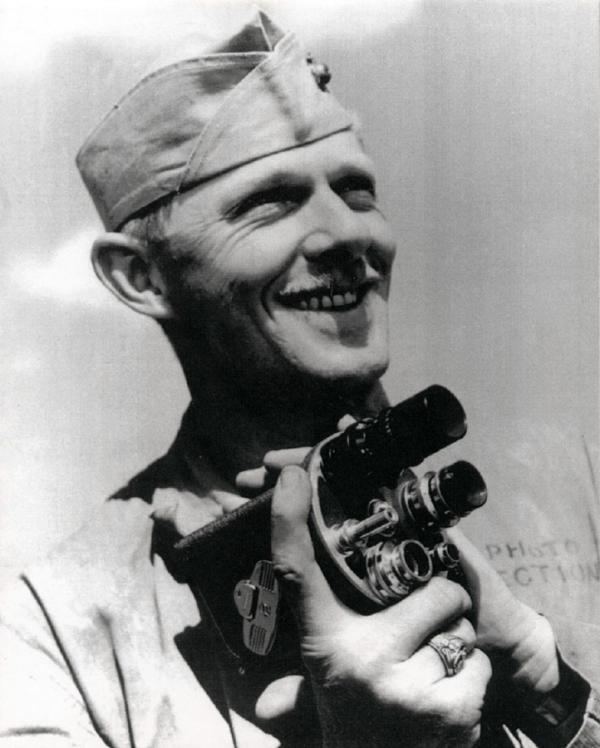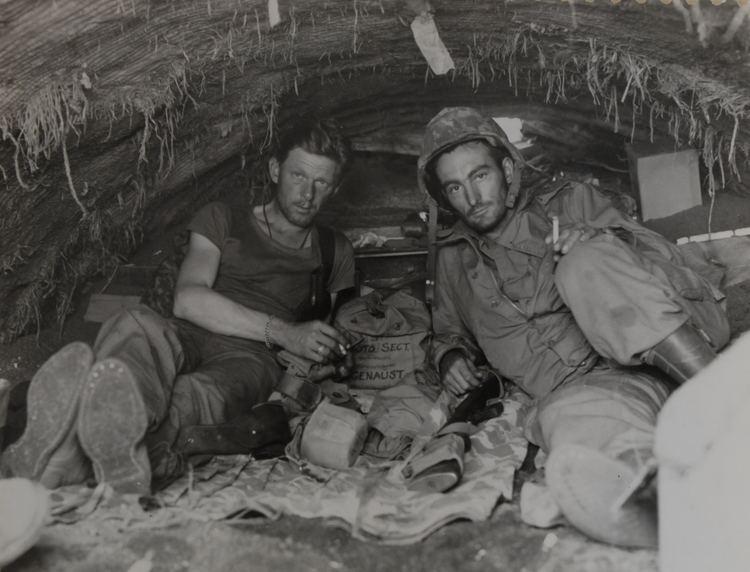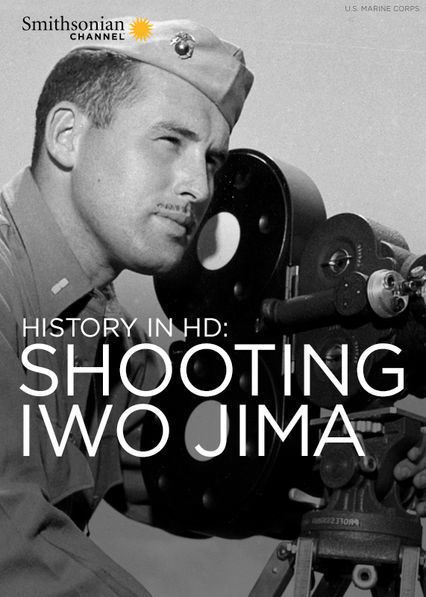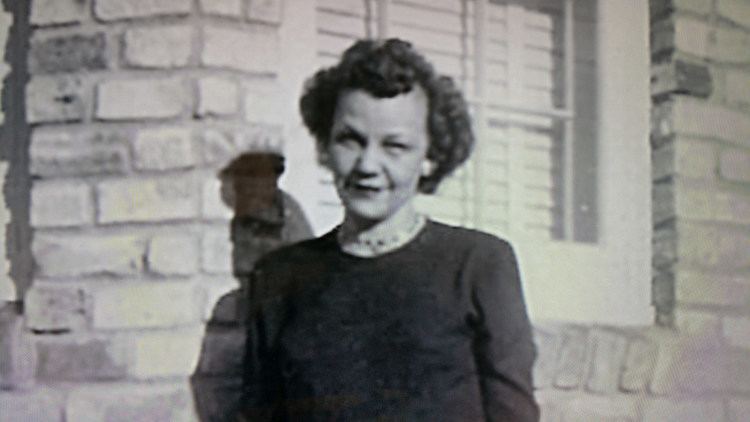Name Bill Genaust | ||
 | ||
Died March 4, 1945, Iwo Jima, Japan | ||
Bill Genaust
William Homer "Bill" Genaust (October 12, 1906 – March 4, 1945) was a United States Marine Corps sergeant who was killed in action on Iwo Jima while serving as a war photographer in World War II. He is best known for filming the second U.S. flag-raising on top of Mount Suribachi on February 23, 1945, during the battle of Iwo Jima, using a then modern and lightweight 16 millimeter motion picture camera which used 50-foot color film cassettes. His motion picture of the flag-raising became one of the best-known film clips of the war. The Marine Corps War Memorial in Arlington, Virginia, depicts the second flag-raising on Mount Suribachi by six Marines.
Contents
- Bill Genaust
- World War II
- Battle of Saipan
- Battle of Iwo Jima
- Marine Corps War Memorial
- Military awards
- Honors
- References

World War II

Genaust enlisted in the Marine Corps at Minneapolis, Minnesota on February 11, 1943 to be a combat cameraman. After recruit training, he was sent to Quantico, Virginia to become a Marine Corps still photographer and motion picture camera photographer.
Battle of Saipan

Genaust served in the Pacific Theater during World War II and was posthumously awarded the Bronze Star Medal with Combat "V" (and Purple Heart Medal) in September 1945 for heroic actions using a rifle in a firefight on Saipan where he was wounded on July 9, 1944. He was recommended for the Navy Cross by Norman Hatch, his photo section commander, but the nomination was turned down because Genaust was a cameraman and not an infantryman. He also shared in the Navy Presidential Unit Citation awarded to the 4th Marine Division for the Battle of Saipan and Tinian (June 15 to August 1, 1944). It took 8 months for Genaust to recover from his leg wound he obtained on Saipan. He was given the offer to go back home, but instead volunteered to go to Iwo Jima.
Battle of Iwo Jima

Genaust was next assigned to help train Marine photographers on how to film in a combat zone. Then, three Marine divisions in a force of approximately 70,000 servicemen which include about 60 Marine Cameramen and Genaust are about to assault Iwo Jima. Genaust would accompany the Marine infantrymen riding in and on landing craft. On February 19, filming on the way in, he lands on the beach with members of the 4th Marine Division (4th and 5th divisions landed on February 19). On the third day, he heads closer in towards Mount Suribachi where the 28th Marines, 5th Marine Division are located with orders to capture Suribachi and is teamed with Marine still photographer Pfc. Bob Campbell, and proceeds to take more film action at the base of Suribachi.

On February 23, 1945, a 40-man patrol consisting primarily of members of Third Platoon, E Company, 2nd Battalion, 28th Marines, 5th Marine Division was ordered to climb up Mount Suribachi and seize and occupy the summit. The patrol was led by E Company's executive officer, First Lieutenant Harold Schrier who had taken over the platoon and volunteered for the mission and raise the battalion's small American flag to signal the volcano was captured. The flag attached to a Japanese iron water pipe was raised approximately 10:30 a.m. by Schrier, his platoon sergeant, and another sergeant. Marine photographer Staff Sergeant Lou Lowery accompanied the patrol and photographed the Marines and Navy corpsmen climbing to the top of Mount Suribachi, the Marines tying the flag on the pipe, and the men around the flagstaff after it was raised.

Around noon, Marine photographers Sergeant Genaust and Private Campbell are ordered up Mount Suribachi. On the way up, they meet Associated Press (AP) photographer Joe Rosenthal who first arrived on Iwo Jima with the 4th Marine Division on February, 19 (he went back and forth from a ship each day), but missed the first flag raising on top. The three photographers proceed to climb up Mount Suribachi as a 4-man team of Marines from Second Platoon, E Company, also climb up with orders to raise a large replacement flag on top. Once on top, another Japanese pipe is found and the second flag is attached unto it which would make the American flag visible from any point on the island. On the way up, Rosenthal, Genaust, and Campbell met Lowery coming down who tells them about the first American flag raising. After the three are on top, Genaust with his motion picture camera stood at the left side of Rosenthal and filmed the second flagstaff being hoisted by six Marines (four Marines from Second Platoon, E Company, an E Company Marine runner who climbed up the mountain with the replacement flag, and a Marine who was a member of the original 40-man patrol on top).
Under Lt. Schrier's orders, the larger flag was raised as the smaller flag was lowered. Genaust's film captures the six Marines getting in place to raise the larger flag, the raising of the flagstaff, and the securing of the bottom of the flagstaff with rocks. Rosenthal became famous for taking the black and white photograph of the replacement flag raising which appeared in Sunday newspapers on February 25. Similar still photographs were also taken on top of Mount Suribachi by Campbell and other photographers including a U.S. Army and U.S. Coast Guard photographer. Genaust's film also captures other Marines on the summit as they gaze up during the second flag raising. These Marines are not visible in Rosenthal's famous photograph.
Death
Genaust and possibly another Marine were killed on March 4 (Genaust was listed as MIA on March 3), 1945 by Japanese small arms fire after they entered a large cave at or around Hill 362-A, located on the northern part of Iwo Jima. Genaust volunteered to go in the cave, and more likely used his flashlight instead of his camera light inside the cave. After he was killed, the cave entrance was covered over by bulldozing equipment, and despite renewed search efforts in 2007, his and the other Marine's body have never been recovered. Genaust is among 250 listed missing on Iwo Jima, although most of those Americans were lost at sea.
Marine Corps War Memorial
The Marine Corps War Memorial (also known as the Iwo Jima Memorial) in Arlington, Virginia which was inspired by Rosenthal's photograph of the second flag-raising by six Marines atop Mount Suribachi on February 23, 1945, was dedicated on November 10, 1954.
President Dwight D. Eisenhower sat upfront with Vice President Richard Nixon, Deputy Secretary of Defense Robert Anderson, and General Lemuel C. Shepherd, the 20th Commandant of the Marine Corps during the dedication ceremony. Two of the three surviving flag-raisiers depicted on the monument, Ira Hayes and Rene Gagnon, were seated together with John Bradley (a Navy corpsman who was incorrectly identified as being a flag-raiser) in the front rows of seats along with relatives of those who were killed in action on the island. Speeches were given by Richard Nixon, Robert Anderson who dedicated the memorial, and General Shepherd who presented the memorial to the American people. Inscribed on the memorial are the following words:
In Honor And Memory Of The Men of The United States Marine Corps Who Have Given Their Lives To Their Country Since 10 November 1775On June 23, 2016, the Marine Corps announced that former Navy corpsman John Bradley (deceased) who was depicted as the third bronze statue from the bottom of the flagstaff on the monument, was not in the Rosenthal photograph and former Marine Harold Schultz (deceased) was. Franklin Sousley and Schultz are depicted as the third and fifth bronze statues from the bottom of the flagstaff with the 32 foot (9.8 M) bronze statues of Harlon Block (first statue), Rene Gagnon (second statue), Michael Strank (fourth statue), and Ira Hayes (six statue) on the monument.
Military awards
Genaust's military decorations and awards include:
Genaust received a posthumous Certificate of Appreciation from the Commandant of the Marine Corps, General Paul X. Kelley on 26 April 1984.
Honors
The Sergeant William Genaust Award is presented each year by the Marine Corps Heritage Foundation, one of a series of awards to both Marines and civilian community members recognizing their work in advancing and preserving Marine Corps history. It is given for a documentary and short subject (15 minutes or less) dealing creatively with U.S. Marine Corps heritage or Marine Corps life.[4]
